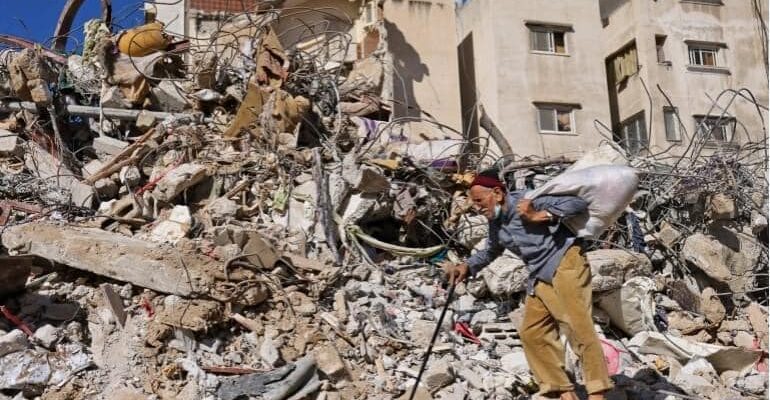I first met Ahmed Najar at the end of last year: an event in London to raise funds for Medical Aid for Palestinians. At first glance he looked like a Palestinian Hugh Grant, all floppy dark hair and shy smile. But when he stood to speak, Ahmed was a powerhouse. No polite rhetoric about ‘the Israeli-Palestinian conflict;’ he stated that genocide was beginning across Gaza, and we needed to be clear about the agenda of the Israeli government to finish the job.
Ahmed is a Palestinian from Gaza. He was born in Jabalia refugee camp in northern Gaza, that now lies in ruins as people try to survive constant bombs, tanks and snipers that have killed at least six hundred and fourty Palestinians across the North these previous three weeks. An Al-Jazeera correspondent in Gaza reports that survivors are ‘trapped’ in their homes amidst a ‘mass blackout’ and that women fleeing to northern Gaza say their Palestinian men are being arrested and detained at Israeli military checkpoints.
I have previously spent a lot of time in Jabalia. I know its crowded streets, the busy markets, and narrow cheek-by jowl houses and apartments; I have seen the camp after previous invasions by the Israeli military. I remember sitting in Jabalia with Anwar Balousha as he mourned his five dead daughters – Ikram and her sisters Tahrir, Samar, Dina and Jawaher – killed together in their home by an Israeli missile in December 2008. You might say this is terrible, but it was a long time ago. That is the point. The Israeli government has been at war with Gaza for years. This current stranglehold (can we please stop calling this a conflict) is only the latest iteration of Israeli government policy to asphyxiate Gaza. This was also the purpose of the long-term siege of Gaza that began back in June 2007.
The brutal utterly unjustifiable Hamas attack of October 2023 does not in turn justify these now thirteen months of laying waste to a people, including the deliberate destruction of its culture. I see images of these constricted Jabalia streets choked in rubble, and I know that people cannot escape, because there’s no-where to escape to.
The death narratives (because there are no other words for these reports) still emerging from inside Gaza are thanks to the unyielding courage of Palestinian journalists; 130 Palestinian journalists and media workers have been killed this last year, a figure that should haunt us all. Alongside these updates from Palestinians reporting this war from inside, two other piece of writing stay with me day and night.
The first is a new report from Save the Children, that states the Occupied Palestinian Territories are ‘the deadliest place in the world for children’ with at least 11,300 children killed between October 2023 – September 2024. An earlier report by the same NGO warned that up 21,000 Palestinian children are ‘lost, disappeared, detained [or] buried under the rubble or in masse graves in Gaza’.
The second is a piece by Ahmed Najar, published on 20th October, about what he calls the ‘nightmare of Gaza’. Ahmed describes talking with sister in Jabalia by phone; she breaks down because she can’t take any more. She is ‘exhausted, worn down to her very core and has reached breaking point’. She just wants to die. Ahmed wants to howl. He wants to know how Palestinians in Gaza can continue living, ‘when they have run out of ways to survive’.
He asks the most basic, fundamental questions, the most urgent questions about this war of revenge with no end. ‘what has happened to the world? what has happened to our sense of justice, of decency, of basic human compassion?’ And he ends with a warning, that ‘I am terrified for humanity, because if we allow this to happen, if we stand by and watch as an entire people are destroyed, then what hope do we have? What does that say about us, about our world, and about the future of our children?’
This we must each wrestle with.
photo from Gaza (prior to 2023)

